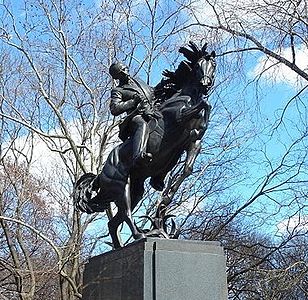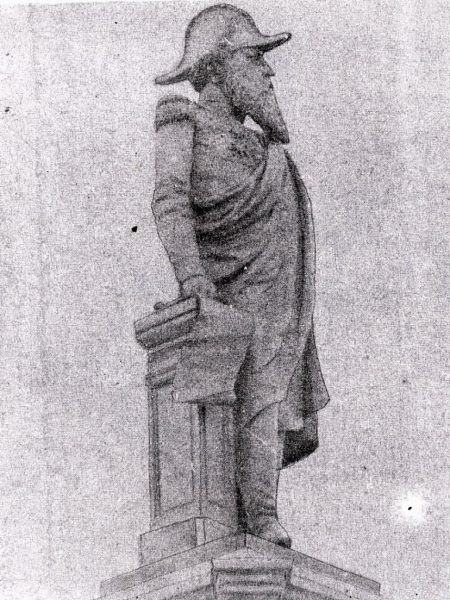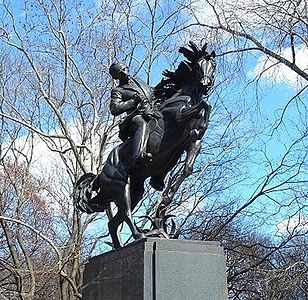
By Vicente Morín Aguado
HAVANA TIMES – Millions of visitors have seen José Martí, his chest offered to the bullets, riding a horse with its front legs raised, a symbol of death, last equestrian figure sculpted by US artist Anna Hyatt Huntington, commissioned by the Cuban government for the people of the United States, planted on the south side of Central Park in New York.
When passing in front of the imposing sculpture, the visitor can read the following inscription, embedded in black granite:
“José Martí: apostle of Cuban independence / guide of the American peoples / and champion of human dignity / his literary genius rivals his / political foresight / born in Havana on January 28, / 1853. He lived fifteen years of his / exile in the city of New York / died in the battle of / Dos Rios province of Oriente / on May 19, 1895.”
The only episode of violence due to his vocation, imposed by the manners of the 19th century, was so strange to the conduct of a poet that Rubén Darío, upon learning of the sacrifice, exclaimed: “Master, what have you done!”
The phrase, from poet to poet, had its background in the trajectory of the Cuban poet, founder alongside his Nicaraguan counterpart Ruben Dario of Modernism. A year after Martí disembarked in Manhattan, on January 10, 1881, the Revista Ilustrada de Nueva York published his “Nuestra América,” (Our America) where he foresaw the epic of María Corina Machado by writing:
“A vigorous idea, waved before the world at the right time, can stop, like the mystical flag of the final judgment, a squadron of battleships.”
Martí is often quoted as if he were a biblical prophet, but the sentence above is not the result of a random selection to support a speech; it expresses a political ideal because, word by word, concept by concept, it aligns with the strategy of the Venezuelan opposition against the Maduro dictatorship, which has turned into a tyranny now in its final self-destructive phase.
The vigorous idea was to prove the electoral fraud whose execution was known in advance. Waved before the world at the right time because in less than 24 hours, faithful copies of the precinct voting results were presented, in sufficient quantity to irrefutably validate the popular will in electing Edmundo Gonzalez, while these proofs are available for anyone, inside or outside the country, who wishes to consult them.
As for the mystical flag, thousands of Venezuelans have turned it into a symbol of their demands for respect for popular sovereignty, a peculiar ceremony: raising rosaries to the sky in the parks of cities, praying for peace and national harmony.
Regarding the squadron of battleships, any resemblance to the criminal gang that has taken over the country is not mere coincidence; it is an eloquent simile.
Martí’s idea constitutes one of the pillars of what has come to be called “A Force More Powerful,” the title of a series of publications sponsored by The International Center on Nonviolent Conflict (ICNC), www.nonviolent-conflict.org, whose work summarizes the historical experience of nonviolent struggles worldwide.
A series of six documentaries, books, and other materials published by the reference center recount, among other cases, the independence of India, the end of apartheid in South Africa, the civil rights struggle against racism in the United States, the Danish resistance to Hitler’s occupation, the decline of totalitarian communism in Poland, and the transition to democracy in Chile.
Jose Marti lived six months of his short life in Caracas, where he arrived from New York on January 21, 1881. An exiled friend in the Big Apple, Nicanor Bolet Peraza, had warned him about the prevailing authoritarianism in his country, governed by Antonio Guzmán Blanco.

The desire to connect with Bolívar and his people was stronger, and the Cuban was received with unusual appreciation by the Caracas intellectual community despite his mere 28 years. From a city balcony, Martí gave a speech interrupted many times by applause, where he seemed to be portraying today:
“Caracas, the capital of the Republic, the Jerusalem of South Americans, the cradle of the free continent, where Andres Bello, a Virgil, studied; where Bolivar, a Jupiter, was born; where both the myrtle of poets and the laurel of warriors grow; where all that is great has been thought and all that is terrible has been suffered; where Freedom, having fought so much there, is wrapped in a mantle stained with its own blood.”
However, the historical scene did not mislead the visitor, for on that March 21, 1881, the young Cuban warned those present: “I come to ask the children of Bolívar for a place in the militia of peace.”
The inevitable clash with the dictator came soon, when, already a journalist and teacher in the Venezuelan capital, he visited the veteran educator Cecilio Acosta on a couple of occasions, renowned in educational circles as a “philosopher who forged consciences.”
Cecilio Acosta was the personification of Martí’s apostolate for freedom, a symbolic opponent of Guzmán Blanco, one of whose statues, shamelessly erected by order of the autocrat, was quietly nicknamed “El Manganzon,” meaning a person who has enriched themselves without working.
The sudden death of the veteran dissident prompted an article signed by Martí, a public tribute to Acosta’s civic virtues. The dictator’s response was to demand a public retraction from the Cuban or leave the country.
About to board the ship back to the United States due to his refusal to yield to Guzmán Blanco’s blackmail, Martí wrote to the director of the newspaper La Opinion Nacional of Caracas, Fausto Teodoro Aldrey: “Give me Venezuela in which to serve her: she has in me a son.”
Read more from Cuba here on Havana Times.




